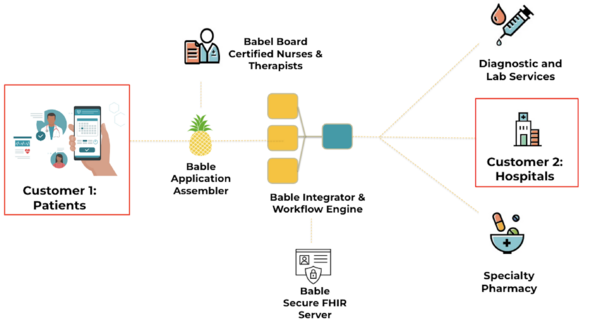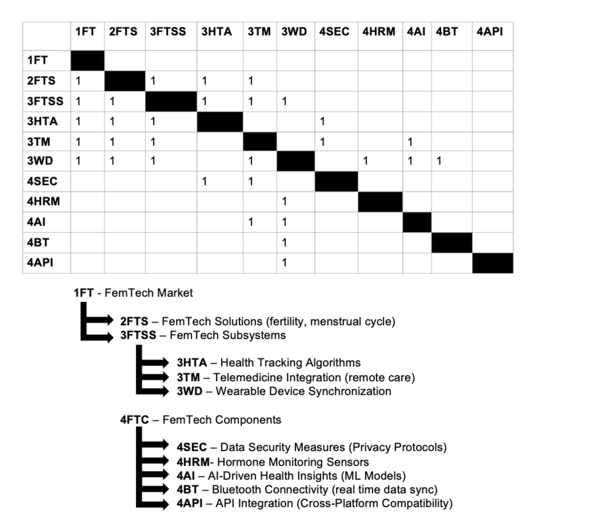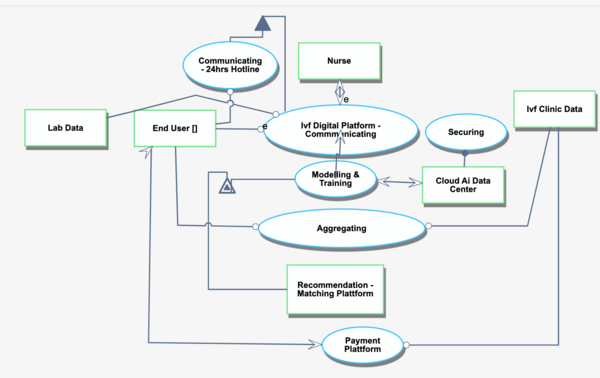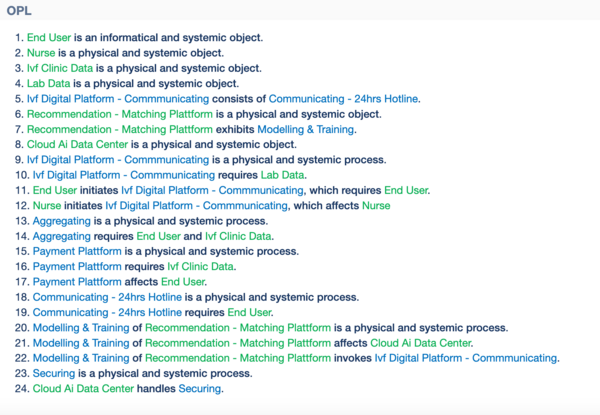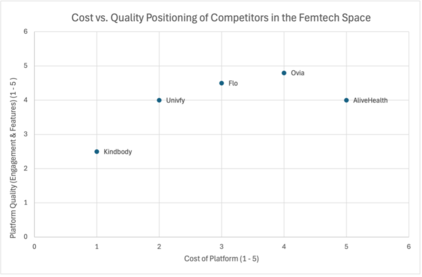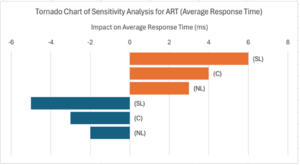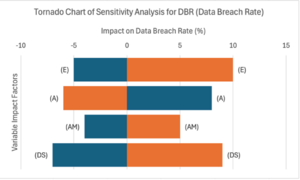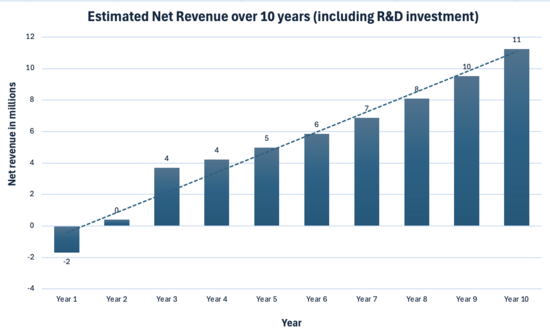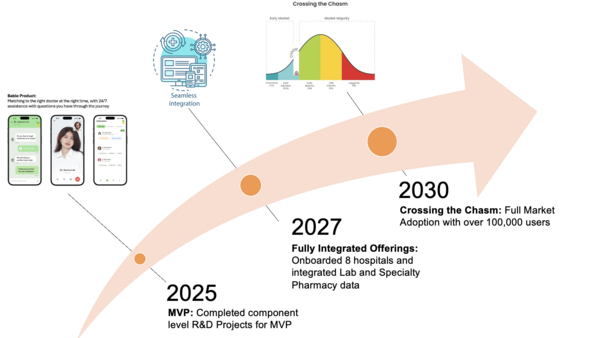Difference between revisions of "FemTech"
| (24 intermediate revisions by the same user not shown) | |||
| Line 3: | Line 3: | ||
== Technology Roadmap Overview == | == Technology Roadmap Overview == | ||
FemTech refers to a transformative category of technology designed to address a wide spectrum of | FemTech refers to a transformative category of technology designed to address a wide spectrum of Women’s health challenges, from reproductive health and pregnancy to chronic conditions and overall wellness. These technologies bridge the gap between Women and healthcare providers, leveraging digital platforms to track health data, offer tailored recommendations, and ensure timely access to care. | ||
While advancements in fertility and period tracking tools have made strides, significant gaps remain in delivering a cohesive and supportive patient experience, particularly for Women undergoing complex treatments such as in-vitro fertilization (IVF). The IVF process can be emotionally overwhelming, administratively complex, and logistically challenging. Patients often face fragmented communication, scheduling delays, and limited visibility into their treatment journey. These pain points contribute to heightened stress and dissatisfaction during an already sensitive time. | |||
[[File:FemTech_Picture.png | Our roadmap focuses on combating these challenges by integrating advanced digital innovations tailored specifically for the fertility care ecosystem. By addressing critical inefficiencies in communication, data integration, and care coordination, our FemTech Digital Platform optimizes patient navigation throughout their IVF journey. Through the use of Artificial Intelligence, telemedicine, and secure data-sharing technologies based on FHIR servers, this platform is uniquely positioned to: | ||
* Streamline communication: Enable seamless interaction between patients, clinics, labs, and pharmacies. | |||
* Provide real-time access: Deliver live updates on appointments, treatment plans, and educational resources to support informed decision-making. | |||
* Reduce administrative burdens: Automate workflows to simplify the processes for both patients and healthcare staff. | |||
* Ensure robust data security: Implement state-of-the-art encryption protocols and secure access methods to protect sensitive medical information. | |||
Ultimately, this platform aims to enhance patient support, simplify the IVF experience, and improve health outcomes by creating a seamless, empowering journey for Women navigating fertility treatments. | |||
[[File:FemTech_Picture.png|600px|Caption for image]] | |||
== DSM Allocation == | == DSM Allocation == | ||
The Design Structure Matrix (DSM) shown below represents the relationships between different levels of the FemTech ecosystem, from broad market categories (Level 1) to specific technological components (Level 4). | |||
* Rows and Columns: Each row and column corresponds to a specific element in the FemTech hierarchy. | |||
* Diagonal Cells: Black cells along the diagonal represent the element itself. | |||
* Off-Diagonal Cells: A black cell in an off-diagonal position indicates a dependency or interaction between the corresponding row and column elements. For example, a black cell at the intersection of 3HTA (Health Tracking Algorithms) and 4AI (AI-Driven Health Insights) shows that these two components are closely related. | |||
* Hierarchy Levels: 1FT: Broad FemTech Market. 2FTS: FemTech Solutions (e.g., fertility and menstrual cycle management). 3FTSS: Subsystems such as health tracking algorithms, telemedicine integration, and wearable synchronization. 4FTC: Specific technological components like AI-driven health insights, hormone sensors, or data security measures. | |||
This matrix visually maps the interdependencies in the FemTech ecosystem, highlighting how higher-level categories rely on or influence more detailed technological elements. | |||
[[File:DSM Final.png|600px]] | [[File:DSM Final.png|600px]] | ||
| Line 17: | Line 35: | ||
Below, we provide an object-process diagram (OPD) of the IVF Digital Platform roadmap. This diagram captures the main object of the roadmap, its decomposition into subsystems, its characterization by Figures of Merit (FOMs), as well as the main processes and actors involved. | Below, we provide an object-process diagram (OPD) of the IVF Digital Platform roadmap. This diagram captures the main object of the roadmap, its decomposition into subsystems, its characterization by Figures of Merit (FOMs), as well as the main processes and actors involved. | ||
[[File: | [[File:OPMF.png|600px]] | ||
[[File: | [[File:OPL NEW.png|600px]] | ||
==Figures of Merit== | ==Figures of Merit== | ||
| Line 139: | Line 157: | ||
[[File:Tornado ChartFMT.png|thumb|right]] | [[File:Tornado ChartFMT.png|thumb|right]] | ||
The primary | ART Analysis: Platform Responsiveness | ||
The tornado chart for Average Response Time (ART) highlights the factors that most significantly impact platform responsiveness. Based on our sensitivity analysis, the primary parameters influencing ART include System Load (SL), Server Capacity (C), and Network Latency (NL). These findings have critical implications for optimizing user experience in the context of fertility treatments: | |||
* System Load (SL): Managing system load is essential to maintaining optimal performance during peak usage periods, such as IVF cycle coordination when multiple patients, clinicians, and laboratories are accessing the platform simultaneously. A well-balanced load management strategy ensures that live updates, appointment tracking, and communications remain seamless, reducing patient stress and preventing disruptions in care. | |||
* Server Capacity (C): Enhancing server capacity directly impacts the speed of data processing and response, allowing patients to access real-time updates on their treatment plans without delays. This is particularly crucial in time-sensitive scenarios like medication schedule changes or laboratory test results. | |||
* Network Latency (NL): Although it plays a smaller role, minimizing latency ensures smooth telemedicine consultations and secure data transmissions, improving the overall patient-clinic interaction. | |||
Key Takeaway: Ensuring platform performance through investments in load balancing technologies, server scaling, and optimized network protocols is crucial for maintaining patient trust and satisfaction. | |||
[[File:Tornado 2FMT.png|thumb|right]] | [[File:Tornado 2FMT.png|thumb|right]] | ||
The | DBR Analysis: Data Security | ||
The tornado chart for Data Breach Risk (DBR) identifies the variables that impact the security of sensitive patient data. Fertility treatments involve highly personal information, making robust security measures a cornerstone of the platform. Key insights include: | |||
* Encryption Level (E): High-level encryption protocols, such as AES-256, are essential to protect medical records and other sensitive data from unauthorized access. In the FemTech context, ensuring data confidentiality builds trust among patients navigating fertility treatments. | |||
* Access Frequency (A): Limiting access frequency and exposure points, such as ensuring that only authorized users access specific data, significantly reduces the risk of breaches. | |||
* Authentication Method (AM): Multi-Factor Authentication (MFA) is prioritized to ensure that patient data remains secure during interactions with the platform. | |||
* Data Storage (DS): Utilizing encrypted cloud storage and secure database solutions mitigates risks associated with local storage vulnerabilities. | |||
Key Takeaway: By integrating robust encryption and multi-factor authentication protocols, the platform ensures patient privacy and compliance with healthcare regulations such as HIPAA, further strengthening trust in the FemTech solution. | |||
Both performance (ART) and security (DBR) are interconnected in delivering a seamless and secure experience. For example: | |||
* Efficient management of system load and server capacity not only improves responsiveness but also ensures that encryption protocols and secure access methods do not compromise performance. | |||
* Similarly, strong encryption and secure data storage measures protect against data breaches without causing delays in patient-clinic communications. | |||
This integrated approach to system optimization highlights the dual commitment to delivering both operational efficiency and patient confidentiality, addressing the unique needs of Women navigating the complexities of fertility care. | |||
<gallery widths=500px heights=277px> | <gallery widths=500px heights=277px> | ||
| Line 239: | Line 265: | ||
==Key Patents and Publications== | ==Key Patents and Publications== | ||
Chatbots: | Chatbots: This section outlines key patents related to chatbot and large language model (LLM) technologies for an IVF platform. These patents showcase advancements in conversational AI, personalization, and integration, making them potential building blocks for patient-centric and efficient IVF solutions. | ||
* Focuses on methods for operating and building chatbots using conversation data structures. Uses pattern matching and natural language processing techniques. Allows for dynamic node resolution to flexibly switch between conversation paths. The application is related to PCT Application Nos. PCT/AU2007/000912 and PCT/AU2007/000916, the content of which is incorporated herein by reference. (https://patents.google.com/patent/US9369410B2/en) | * Focuses on methods for operating and building chatbots using conversation data structures. Uses pattern matching and natural language processing techniques. Allows for dynamic node resolution to flexibly switch between conversation paths. The application is related to PCT Application Nos. PCT/AU2007/000912 and PCT/AU2007/000916, the content of which is incorporated herein by reference. (https://patents.google.com/patent/US9369410B2/en) | ||
* Exploring LLM Capabilities: "Fluid Transformers and Creative Analogies: Exploring Large Language Models' Capacity for Augmenting Cross-Domain Analogical Creativity" by Ding et al. (2023) https://www.alphaxiv.org/abs/2302.12832v2 | |||
* | |||
Wearables: The FemTech industry is at a transformative crossroads, combining wearable technologies with artificial intelligence to deliver personalized health solutions for Women. | |||
* Insights from wearable advancements, paired with individualized recommendation systems like the patent US20020161664A1, can drive a new era of FemTech innovation, offering precision care and improved health outcomes. The insights from Gehr and Russmann’s paper on cardiovascular wearables can be used for innovations in FemTech as well https://doi.org/10.1038/s41569-022-00729-2 | |||
Personalized Recommendations for Women’s Health: By incorporating technologies like those described in US20020161664A1, FemTech platforms can offer more than generic wellness advice—they can provide deeply personalized solutions that adapt to each woman’s unique health journey. | |||
* From reactive healthcare to proactive, individualized care, setting a new standard for Women’s IVF journey. Systems and methods for implementing personalized health and wellness programs: https://patents.google.com/patent/US20160217266A1/en | |||
Publications: | |||
* "The Femtech Frontier: Embracing AI for Women's Health in 2024" (Greenbook, 2024) Discusses the potential of AI-powered chatbots to answer questions related to pregnancy, postpartum care, and reproductive health https://www.greenbook.org/insights/healthcare-market-research-experts/the-femtech-frontier-embracing-ai-for-Womens-health-in-2024 | |||
* "Consumer wearables and personal devices for tracking the fertile window" (PubMed, 2024): Identifies 23 different nonprescription wearables and devices designed to help Women track their fertile window https://pubmed.ncbi.nlm.nih.gov/38768799/ | |||
* | |||
* A Framework for Femtech: Guiding Principles for Developing Digital Reproductive Health Tools" (PMC, 2022), Discusses the development of digital reproductive health tools, including wearables, https://pmc.ncbi.nlm.nih.gov/articles/PMC9100540/ | |||
* IVF Stimulation - personalized, optimized, and simplified using an advanced decision support tool" (Journal of IVF Worldwide, 2024) , Presents a clinical decision support tool called Opt-IVF that provides personalized and optimized dosage profiles for IVF stimulation cycles https://jivfww.scholasticahq.com/article/86155-ivf-stimulation-personalized-optimized-and-simplified-using-an-advanced-decision-support-tool-a-randomized-trial | |||
* Alife App Launch" (Femtech Insider, 2024) Describes the launch of a mobile application by Alife Health to help patients navigate their IVF journey https://femtechinsider.com/alife-app-launch/ | |||
* | |||
Latest revision as of 18:00, 3 December 2024
The FemTech (FT) market is a Level 1 roadmap, represents a rapidly expanding segment of the broader digital health market focused on Women's Health.Level 2 roadmaps focus on specific FemTech solutions, such as fertility tracking apps (Bable), menstrual cycle management platforms, pregnancy care, and menopause support technologies. Level 3 roadmaps delve into the subsystems within these solutions, including personalized health tracking algorithms, telehealth integration, and wearable device synchronization. Level 4 roadmaps focus on individual components such as data security measures, hormone monitoring sensors, and AI-driven health insights.
Technology Roadmap Overview
FemTech refers to a transformative category of technology designed to address a wide spectrum of Women’s health challenges, from reproductive health and pregnancy to chronic conditions and overall wellness. These technologies bridge the gap between Women and healthcare providers, leveraging digital platforms to track health data, offer tailored recommendations, and ensure timely access to care.
While advancements in fertility and period tracking tools have made strides, significant gaps remain in delivering a cohesive and supportive patient experience, particularly for Women undergoing complex treatments such as in-vitro fertilization (IVF). The IVF process can be emotionally overwhelming, administratively complex, and logistically challenging. Patients often face fragmented communication, scheduling delays, and limited visibility into their treatment journey. These pain points contribute to heightened stress and dissatisfaction during an already sensitive time.
Our roadmap focuses on combating these challenges by integrating advanced digital innovations tailored specifically for the fertility care ecosystem. By addressing critical inefficiencies in communication, data integration, and care coordination, our FemTech Digital Platform optimizes patient navigation throughout their IVF journey. Through the use of Artificial Intelligence, telemedicine, and secure data-sharing technologies based on FHIR servers, this platform is uniquely positioned to:
- Streamline communication: Enable seamless interaction between patients, clinics, labs, and pharmacies.
- Provide real-time access: Deliver live updates on appointments, treatment plans, and educational resources to support informed decision-making.
- Reduce administrative burdens: Automate workflows to simplify the processes for both patients and healthcare staff.
- Ensure robust data security: Implement state-of-the-art encryption protocols and secure access methods to protect sensitive medical information.
Ultimately, this platform aims to enhance patient support, simplify the IVF experience, and improve health outcomes by creating a seamless, empowering journey for Women navigating fertility treatments.
DSM Allocation
The Design Structure Matrix (DSM) shown below represents the relationships between different levels of the FemTech ecosystem, from broad market categories (Level 1) to specific technological components (Level 4).
- Rows and Columns: Each row and column corresponds to a specific element in the FemTech hierarchy.
- Diagonal Cells: Black cells along the diagonal represent the element itself.
- Off-Diagonal Cells: A black cell in an off-diagonal position indicates a dependency or interaction between the corresponding row and column elements. For example, a black cell at the intersection of 3HTA (Health Tracking Algorithms) and 4AI (AI-Driven Health Insights) shows that these two components are closely related.
- Hierarchy Levels: 1FT: Broad FemTech Market. 2FTS: FemTech Solutions (e.g., fertility and menstrual cycle management). 3FTSS: Subsystems such as health tracking algorithms, telemedicine integration, and wearable synchronization. 4FTC: Specific technological components like AI-driven health insights, hormone sensors, or data security measures.
This matrix visually maps the interdependencies in the FemTech ecosystem, highlighting how higher-level categories rely on or influence more detailed technological elements.
OPM Model
Below, we provide an object-process diagram (OPD) of the IVF Digital Platform roadmap. This diagram captures the main object of the roadmap, its decomposition into subsystems, its characterization by Figures of Merit (FOMs), as well as the main processes and actors involved.
Figures of Merit
This table outlines the key metrics for evaluating the performance and effectiveness of IVF Digital Platforms.
| Figure of Merit (FOM) | Unit | Description |
|---|---|---|
| Net Promoter Score | 0-10 scale | Measure the average NPS from patients and healthcare providers using the fertility AI platform. |
| Authentication Success Rate | % | Percentage of successful logins without errors. |
| Appointment Scheduling | Minutes | Time saved by patients when booking appointments. |
| Patient Follow Up | Minutes | Time saved due to automated reminders and check-ins. |
| Time Writing Clinical Notes | Minutes | Average reductio in documentation time. |
| Data Integration | Hours | Reduction in time to ingest third party diagnostic/lab data. |
| System Downtime | Seconds | Time the system is down, impacting patient access. |
| A/B Testing of Success Rate | % | Success rate improvement over a 3-year period after implementation. |
Alignment with Company Strategic Drivers
Our software platform enhances patient support through fertility treatments by focusing on three key strategic drivers:
| # | Strategic Driver | Alignment and Targets |
|---|---|---|
| 1 | To create value for users by increasing productivity | - Net Promoter Score (NPS): Target an average NPS of 8 or higher from patients and healthcare providers, indicating strong satisfaction and perceived value of productivity enhancements.
- Authentication Success Rate: Achieve a 99% authentication success rate to ensure efficient, reliable user access, which supports productivity. - Appointment Scheduling: Reduce appointment scheduling time by 50%, streamlining productivity and easing patient experiences. - Patient Follow-Up: Target a 30% reduction in time spent on patient follow-ups through automated reminders and check-ins, helping users focus on essential tasks. |
| 2 | To ensure the quality and accuracy of the generated outputs that users can trust | - A/B Testing Success Rate: Improve success rate by 10% over 3 years through continuous A/B testing, refining algorithm accuracy and trustworthiness.
- Data Integration: Target 2 hours per week saved in data ingestion, making third-party lab and diagnostic data integration faster and more reliable. - System Downtime: Limit system downtime to 30 seconds per month, maintaining continuous, dependable access that supports reliability and trust. |
| 3 | To deliver a seamless user experience with robust compatibility for business clients, ensuring smooth integration with other systems. | - Appointment Scheduling: Achieve 95% compatibility with third-party scheduling systems, enhancing integration and ease of use.
- Data Integration: Reduce time spent on data integration tasks by 50% through improved interoperability with other systems. - System Downtime: Target 99.9% system uptime, allowing a stable experience for users interacting across platforms. |
Positioning of Company vs. Competition
The figure below shows a comparative summary of digital health market competitors.
In our analysis of our technology against competitors, we initially aimed to use specific FOMs such as Data Breach Rate (DBR) and Average Response Time (ART) to provide a direct comparison of performance metrics that are critical for users in the femtech space. However, after review, we found that DBR and ART metrics for our competitors are not readily available through public sources. Unlike cost and feature quality, which can be inferred from published data, user reviews, or pricing models, DBR and ART metrics are often proprietary, sensitive information that companies do not disclose openly.
Given these limitations, we are unable to reliably gather accurate data for these specific FOMs across our competitor landscape. Therefore, attempting to compare Babble to competitors using DBR and ART would involve too much speculation, potentially leading to misleading conclusions. Instead, we will focus on readily available and inferable metrics such as Cost vs. Quality. This comparison allows us to provide a meaningful and transparent analysis of how Bable stands against competitors in terms of the value proposition—the balance between the cost of the platform and the quality of features and engagement it offers. By focusing on Cost vs. Quality, we can use data that is more publicly accessible, consistent, and reliable, ultimately providing a clearer picture of our positioning in the femtech space
Cost Scores (ranked 1-5) are determined based on available subscription rates, or in the case of Kindbody and Univfy, a more personalized cost structure.
Quality Scores (ranked 1-5) are based on user ratings from app stores, as well as qualitative feedback from reviews and the overall experience provided by each platform.
Cost Score (1-5):
1. Flo:
- Offers both free and premium tiers.
- Premium pricing is $7.99/month or $39.99/year
- This positions Flo in the mid-range, giving it a Cost Score of 3.
2. AliveHealth (Alive by Whitney Simmons):
- Pricing is higher at $14.99/month or $119.99/year.
- This justifies a Cost Score of 5 due to the premium pricing compared to others.
3. Ovia:
- Offers a free version with optional in-app purchases and employer-sponsored plans.
- Given the variability but availability of free features, Cost Score of 4 reflects its value relative to its market.
4. Kindbody:
- Provides personalized services, typically based on consultations, making upfront costs hard to determine.
- This variability and potential high cost give it a Cost Score of 1, indicating uncertainty.
5. Univfy:
- Like Kindbody, cost is personalized through clinic partnerships.
- Assign a Cost Score of 2 for being slightly more accessible but still highly personalized.
Quality Score (1-5):
1. Flo:
- With an iOS rating of 4.8/5 and Google Play 4.6/5, user satisfaction is very high.
- This warrants a Quality Score of 4.5.
2. AliveHealth:
- App Store rating of 4.9/5 indicates very strong user satisfaction, focusing on workout variety and motivation.
- Assign a Quality Score of 4.
3. Ovia:
- Very well-rated with 4.8/5 on the App Store.
- Due to positive reviews, assign a Quality Score of 4.8.
4. Kindbody:
- Lacks app-specific ratings and relies more on user feedback about clinic experience.
- Given the absence of direct app ratings and less broad use, a Quality Score of 2.5 reflects more mixed experiences.
5. Univfy:
- Focuses on clinic partnerships and a data-driven approach.
- Users appreciate predictive power, resulting in a Quality Score of 4.
Technical Model
ART Analysis: Platform Responsiveness The tornado chart for Average Response Time (ART) highlights the factors that most significantly impact platform responsiveness. Based on our sensitivity analysis, the primary parameters influencing ART include System Load (SL), Server Capacity (C), and Network Latency (NL). These findings have critical implications for optimizing user experience in the context of fertility treatments:
- System Load (SL): Managing system load is essential to maintaining optimal performance during peak usage periods, such as IVF cycle coordination when multiple patients, clinicians, and laboratories are accessing the platform simultaneously. A well-balanced load management strategy ensures that live updates, appointment tracking, and communications remain seamless, reducing patient stress and preventing disruptions in care.
- Server Capacity (C): Enhancing server capacity directly impacts the speed of data processing and response, allowing patients to access real-time updates on their treatment plans without delays. This is particularly crucial in time-sensitive scenarios like medication schedule changes or laboratory test results.
- Network Latency (NL): Although it plays a smaller role, minimizing latency ensures smooth telemedicine consultations and secure data transmissions, improving the overall patient-clinic interaction.
Key Takeaway: Ensuring platform performance through investments in load balancing technologies, server scaling, and optimized network protocols is crucial for maintaining patient trust and satisfaction.
DBR Analysis: Data Security The tornado chart for Data Breach Risk (DBR) identifies the variables that impact the security of sensitive patient data. Fertility treatments involve highly personal information, making robust security measures a cornerstone of the platform. Key insights include:
- Encryption Level (E): High-level encryption protocols, such as AES-256, are essential to protect medical records and other sensitive data from unauthorized access. In the FemTech context, ensuring data confidentiality builds trust among patients navigating fertility treatments.
- Access Frequency (A): Limiting access frequency and exposure points, such as ensuring that only authorized users access specific data, significantly reduces the risk of breaches.
- Authentication Method (AM): Multi-Factor Authentication (MFA) is prioritized to ensure that patient data remains secure during interactions with the platform.
- Data Storage (DS): Utilizing encrypted cloud storage and secure database solutions mitigates risks associated with local storage vulnerabilities.
Key Takeaway: By integrating robust encryption and multi-factor authentication protocols, the platform ensures patient privacy and compliance with healthcare regulations such as HIPAA, further strengthening trust in the FemTech solution.
Both performance (ART) and security (DBR) are interconnected in delivering a seamless and secure experience. For example:
- Efficient management of system load and server capacity not only improves responsiveness but also ensures that encryption protocols and secure access methods do not compromise performance.
- Similarly, strong encryption and secure data storage measures protect against data breaches without causing delays in patient-clinic communications.
This integrated approach to system optimization highlights the dual commitment to delivering both operational efficiency and patient confidentiality, addressing the unique needs of Women navigating the complexities of fertility care.
We used the following variables for the Morphological Matrix and Tradespace Evaluation:
- Authentication Method (AM): Defines security level (MFA reduces breach likelihood more than SSO)
- Data Storage (DS): Encrypting data reduces breach risk compared to local caching
(Data Breach Rate) DBR = f (AM, DS, EL, AF)
- Encryption Level (EL): Higher levels exponentially decrease breach risk
- Access Frequency (AF): Higher frequency of access may increase breach probability
- Communication Channels (CC): Video requires more resources than text, influencing response time
- Data Storage (DS): Local caching provides faster access but may be less secure than centralized storage
(Average Response Time) ART = f (CC, DS, SL, SC)
- System Load (SL): More concurrent users increase response time
- Server Capacity (SC): Higher capacity improves response time
- DBR Model (Security Focus): DS affects breach risk based on security measures (ex: encryption vs. local storage).
- ART Model (Performance Focus): DS affects response time based on data retrieval speed (ex: local caching vs. remote database access).
R&D Projects
The R&D projects outlined below were chosen for their alignment with our FemTech strategic drivers and their contribution to key figures of merit. While not all projects have been prioritized for immediate investment, each is designed to deliver value and supports the objectives defined in earlier sections of this roadmap. The overarching goal of this roadmap is to enhance efficiency within the warehouse. Each project contributes to achieving this goal in a unique and meaningful way. To ensure continued alignment with market demands and competitive dynamics, project priorities will be reviewed and adjusted as necessary.
Additional Notes:
- TRL (Technology Readiness Level): Indicates the maturity of a technology, from 1 (basic principles observed) to 9 (proven operational capabilities).
- Additional investments like user training modules, continuous compliance updates, and cloud infrastructure optimization could be considered based on the platform's scale and roadmap.
| R&D Project | Technology Area & TRL | Description | Benefits | Challenges | Investment Decision |
|---|---|---|---|---|---|
| Integration with Clinics | System Integration (TRL 4-5) | Develop APIs and middleware to integrate the platform with EMR systems used by clinics. | * Streamlines data exchange, ensures seamless clinic-patient interactions. | * Variability in EMR standards, data security concerns, and compliance with healthcare regulations. | Yes |
| Access to Patient Data | Data Management (TRL 5-6) | Build secure frameworks to access and store patient data, ensuring HIPAA/GDPR compliance. | * Enables personalized care pathways and accurate reporting. | * Compliance with stringent data privacy laws and security risks. | Yes |
| Dual Authentication | Cybersecurity (TRL 6) | Implement two-factor authentication (2FA) for patients and clinical staff to enhance platform security. | * Strengthens user authentication and protects sensitive information. | * Usability concerns for less tech-savvy users, maintaining smooth onboarding processes. | Yes |
| Patient Front-End Development | UX/UI Design & Web Development (TRL 5-6) | Create an intuitive mobile and web interface for patients to access services and communicate with providers. | * SEnhances user experience, fosters engagement, and simplifies access to healthcare. | * Balancing usability with feature complexity. | Yes |
| Clinical Staff Front-End Development | UX/UI Design & Web Development (TRL 5-6) | *Develop a responsive dashboard for nurses and therapists to monitor and manage patient interactions. | * Streamlines clinical workflows, improves communication with patients. | * Adapting the interface for diverse clinical roles and workflows. | Yes |
| Workflow Automation Engine | Workflow Automation (TRL 4-5) | Develop a workflow engine to automate and streamline communication between all stakeholders (patients, staff, labs). | * Reduces manual workload. * Increases operational efficiency * Enables the ability for more advanced operations than navigation * Minimizes overall delays. |
* Managing exceptions and ensuring adaptability for varied use cases. | Yes |
| FHIR Server Implementation | Health IT Standards (TRL 6) | Implement a secure FHIR server to facilitate standardized data sharing across systems. | * Ensures interoperability and simplifies integration with labs and pharmacies. | * High setup and maintenance costs, ensuring compatibility with existing systems. | Yes |
| Integration with Diagnostic Labs | System Integration (TRL 4-5) | Build modules to automate lab order submission and result retrieval. | * Speeds up diagnostics, provides accurate tracking of patient lab results. | * Variability in lab systems and protocols. | Not right now The current platform is sufficient for the current application; once front end systems and security are in place we can integrate with Labs. |
Financial Model
Key Assumptions:
- Project Timeline: Define timeframes for each R&D project (e.g., 1–3 years).
- Cost Estimation: (1) Costs include personnel, software development, testing, and compliance requirements. (2) TRL-based estimates: Lower TRL projects typically incur higher costs due to increased uncertainty and effort.
- Phased Investments: Projects prioritized for immediate investment start earlier, with others phased in based on readiness and strategic importance.
- Market Impact: Benefits measured by cost reduction, efficiency gains, or improved patient and clinical outcomes.
- Contingencies: Include a percentage for unforeseen technical or regulatory challenges (e.g., 10–20%).
This chart illustrates the Estimated Net Revenue for this FemTech company over 10 Years, including the impact of R&D investments (see above) in the early years.
Year 1–2: Significant upfront R&D investments result in negative net revenue (-$2M in Year 1 and break-even by Year 2). Year 3: Net revenue turns positive as cumulative revenues surpass R&D costs, achieving break-even. Years 4–10: Sustained growth in patient subscriptions and hospital partnerships drives exponential revenue increases. By Year 10, net revenue reaches $11M annually, reflecting a strong return on the initial R&D investment. The dashed trend line highlights the steady upward trajectory of net revenue growth after the initial investment period, demonstrating the long-term profitability of the platform.
Technology Strategy Statement
For reference, please see our summary of FemTech Navigation roadmap with swoosh chart showing future growth.
Key Patents and Publications
Chatbots: This section outlines key patents related to chatbot and large language model (LLM) technologies for an IVF platform. These patents showcase advancements in conversational AI, personalization, and integration, making them potential building blocks for patient-centric and efficient IVF solutions.
- Focuses on methods for operating and building chatbots using conversation data structures. Uses pattern matching and natural language processing techniques. Allows for dynamic node resolution to flexibly switch between conversation paths. The application is related to PCT Application Nos. PCT/AU2007/000912 and PCT/AU2007/000916, the content of which is incorporated herein by reference. (https://patents.google.com/patent/US9369410B2/en)
- Exploring LLM Capabilities: "Fluid Transformers and Creative Analogies: Exploring Large Language Models' Capacity for Augmenting Cross-Domain Analogical Creativity" by Ding et al. (2023) https://www.alphaxiv.org/abs/2302.12832v2
Wearables: The FemTech industry is at a transformative crossroads, combining wearable technologies with artificial intelligence to deliver personalized health solutions for Women.
- Insights from wearable advancements, paired with individualized recommendation systems like the patent US20020161664A1, can drive a new era of FemTech innovation, offering precision care and improved health outcomes. The insights from Gehr and Russmann’s paper on cardiovascular wearables can be used for innovations in FemTech as well https://doi.org/10.1038/s41569-022-00729-2
Personalized Recommendations for Women’s Health: By incorporating technologies like those described in US20020161664A1, FemTech platforms can offer more than generic wellness advice—they can provide deeply personalized solutions that adapt to each woman’s unique health journey.
- From reactive healthcare to proactive, individualized care, setting a new standard for Women’s IVF journey. Systems and methods for implementing personalized health and wellness programs: https://patents.google.com/patent/US20160217266A1/en
Publications:
- "The Femtech Frontier: Embracing AI for Women's Health in 2024" (Greenbook, 2024) Discusses the potential of AI-powered chatbots to answer questions related to pregnancy, postpartum care, and reproductive health https://www.greenbook.org/insights/healthcare-market-research-experts/the-femtech-frontier-embracing-ai-for-Womens-health-in-2024
- "Consumer wearables and personal devices for tracking the fertile window" (PubMed, 2024): Identifies 23 different nonprescription wearables and devices designed to help Women track their fertile window https://pubmed.ncbi.nlm.nih.gov/38768799/
- A Framework for Femtech: Guiding Principles for Developing Digital Reproductive Health Tools" (PMC, 2022), Discusses the development of digital reproductive health tools, including wearables, https://pmc.ncbi.nlm.nih.gov/articles/PMC9100540/
- IVF Stimulation - personalized, optimized, and simplified using an advanced decision support tool" (Journal of IVF Worldwide, 2024) , Presents a clinical decision support tool called Opt-IVF that provides personalized and optimized dosage profiles for IVF stimulation cycles https://jivfww.scholasticahq.com/article/86155-ivf-stimulation-personalized-optimized-and-simplified-using-an-advanced-decision-support-tool-a-randomized-trial
- Alife App Launch" (Femtech Insider, 2024) Describes the launch of a mobile application by Alife Health to help patients navigate their IVF journey https://femtechinsider.com/alife-app-launch/
